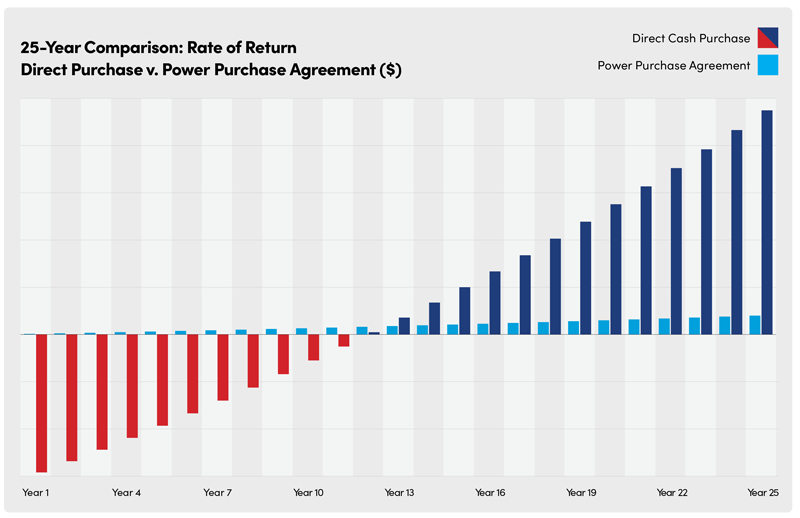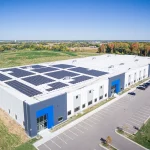America’s transition to renewable energy is already underway. But this transition is no small task and challenges persist. Behind-the-meter solar power is one of the most affordable ways to produce electricity today, but that affordably is seen over decades while the upfront cost of installing solar is immediate. This is a barrier that keeps many cities from going green and adopting lower-cost energy sources. One solution exists to remove this barrier, allowing cities to roll out carbon-free power without tying up funds in capital investment. That solution is called a Power Purchase Agreement (PPA).
What is a Power Purchase Agreement?
A PPA is a contract between a solar energy provider and a municipality in which the provider agrees to install and maintain a solar energy system on the city’s property. The city then agrees to purchase the energy produced by the system at a fixed rate over a set period of time, usually 15 to 25 years. This means that the city does not pay the upfront costs of installing the solar energy system but instead pays for the energy generated by the system at a rate that is usually lower than what they would pay for traditional grid electricity.
What are the benefits of PPAs?
The most significant advantage of a PPA for cities is that it creates a pathway to reduce your carbon footprint and promote renewable energy without having to make a significant upfront investment. The solar energy provider handles the upfront costs of sizing, procuring and installing the solar project. Without any upfront investment, the city is able to adopt solar and begin saving money as soon as the system becomes operational.
PPAs provide an opportunity for cities to deploy a predictable and price-stable source of energy over a long-term contractual period. “Stable” is the keyword here. The rate paid for the electricity generated by the solar energy system is usually fixed for the duration of the contract, while other electricity sources gradually become more expensive year over year. The stability of a PPA can help cities better manage their energy costs and budget for the future — something especially important for cities that are struggling with budget constraints.
What are the challenges associated with a PPA?
As with any type of long-term contract, a PPA can have drawbacks. While a no-upfront cost model is very attractive, the rate of return is mild compared to the more substantial rate of return when purchasing solar arrays outright. See the chart for reference.

This chart reflects a true-to-life Rate of Return Comparison for one municipal customer. Data has been obscured to respect confidentiality.
There are also circumstances where the rate of return (energy savings) can be impacted after a PPA is activated. Steep increases in facility energy usage may provoke a utility provider to modify your rate class, which impacts the projected savings outlined in the PPA. You should understand what happens if your electricity requirements increase over time or if the forecasted energy production is different from the actual production. If the developer goes out of business or ownership changes hands, it’s important that a PPA clearly outlines a contingency plan for that potentiality.
What are the key planning elements for a successful PPA?
While the specifics of a PPA differ from project to project, there are several key elements cities should. discuss with their developer.
- Energy Costs: The electricity rate (preferably a lower rate than existing electricity sources) can be locked-in at the beginning of the PPA or include an annual escalator that increases the rate each year. An escalator may be necessary to account for increases in market energy prices, inflation for system-related costs, project maintenance costs, and array efficiency decreases over time.
- Installation Site Selection: While the developer is responsible for the installation, operation and maintenance of a solar system, the city may need to make investments in their property in order to support the installation of the system, or to comply with local ordinances.
- Quality: With the performance of the PPA tied to the production of the system, investing in a product that has long-term and actionable warranties is a must.
- Fulfillment of the contract: Once the agreement expires, what happens to the array? The usable life of a well-designed and constructed quality solar array can be 30 years and even longer in some instances. Cities should have the opportunity to extend the length of terms for the PPA or negotiate a buyout and outright own the solar array.
What do you consider in selecting a solar provider?
A reputable solar provider will do the following.
- Engage in a consultative process that includes an energy and rate analysis, and will perform a basic site survey. This is done before pursuing any agreement.
- Gain an understanding of the goals and outcomes the city desires to achieve.
- Discuss the benefits of the warranties associated with each product and the installation itself. Beware of vague language that does not name the specific manufacturer of key components like solar panels, racking systems, and inverters.
- Fully explain and document the financial assumptions made in the proposal. Rates, inflation escalators, and production assumptions that are too aggressive create projected returns that may be better than actual results.
An investment in solar is a significant energy efficiency play for a city while also serving as a visual representation of a city’s values. As cities have demonstrated, the benefits of solar are realized through successful partnerships with solar energy providers that offer reliable and efficient systems. By exploring the use of PPAs for solar energy systems, cities and municipalities can take a significant step towards a more sustainable future.
Start a solar conversation today.
Share a few details below and we’ll reach out to you as soon as possible.





